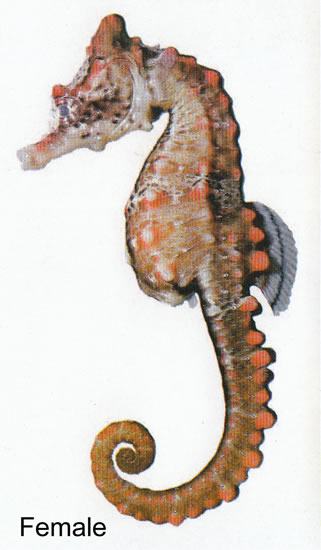- Classification
- ACTINOPTERYGII
- SYNGNATHIFORMES
- SYNGNATHIDAE
- Hippocampus
- tuberculatus
Knobby Seahorse, Hippocampus tuberculatus Castelnau 1875

A Knobby Seahorse, Hippocampus tuberculatus. Source: Rudie Kuiter / Aquatic Photographics. License: All rights reserved
The Knobby Seahorse occurs only in tropical Western Australia and may be found floating amongst Sargassum algae or attached to sponges. The large red tubercles on the back and tail provide camouflage from predators.
Knobby Seahorse, Hippocampus tuberculatus Castelnau 1875
More Info
|
Photo Rights |
GR Allen |
|
Distribution |
Endemic to temperate and tropical Western Australia, from about King George Sound to Onslow, Western Australia. Juveniles and sub-adults often float offshore in Sargassum algae, while adults usually inhabit sponge reefs to 20 m. |
|
Features |
Dorsal fin 20-21; Anal fin 4; Pectoral fin 14-15; trunk rings 11; tail rings 36-37; subdorsal rings 3 + 1. Body spines well-developed; moderately long spine above eyes, with secondary smaller spine anteriorly at base, similar in shape to nasal ridge; small spine behind eye; large lateral head spine; nape spine of moderate size, directed upward; 2 separate low angular spines below eye; 3 moderate to long spines on shoulder ring, uppermost at gill-opening, central spine at level of last pectoral-fin ray, and lowermost largest and recurving; neck ridge with 2 small spines; superior trunk ridge with blunt rounded spines of moderate size, enlarged on rings 1, 3, 5, and subdorsally; lateral trunk ridge with enlarged spines on rings 3, 5, and 7; inferior trunk ridge with last 3 spines enlarged; ventral trunk with low downward directed spines; superior tail ridge with enlarged spines up to about eye-size on every 2nd or 3rd ring, becoming gradually smaller posteriorly; inferior tail ridge a continuation of trunk ridge, with spines gradually reducing in size. adults with large tubercles on back and tail. Coronet tall and angled back, square to rounded in cross section, without spines on corners, but with small central spine on apex, spine angled upward in young, becoming smooth and rounded in mature adults. |
|
Size |
Height to 75 mm. |
|
Colour |
Colour variable depending on habitat. Specimens from floating Sargassum dark brown to blackish with a well defined white area over interorbital extending to base of coronet and tip of snout. Adults on rocky reefs mostly yellow to brown, with a white area over front of head; operculum with black spots; tubercles over back often bright red. In preservative - mainly brown; some with fine black spots on operculum or below dorsal-fin base. |
|
Feeding |
Likely to feed on epibenthic invertebrates such as amphipods, caridean shrimp and peracarids. |
|
Biology |
The female uses an ovipositor to transfer her eggs into an elaborate enclosed pouch under the abdomen of the male. The male not only provides physical protection for the developing embryos, he also osmoregulates and aerates the embryos and may provide some nourishment until the offfspring are born. |
|
Fisheries |
None. There is no known trade in this species in the aquarium or Asian Traditional Medicine industries. |
|
Conservation |
Marine Listed under the Federal Environment Protection and Biodiversity Conservation Act 1999 (EPBC Act 1999). http://www.environment.gov.au/epbc/species/marine.html |
|
Remarks |
Considered by some authors to be a synonym of H. breviceps. |
|
Similar Species |
Similar to H. breviceps from south-eastern Australia, differing in being generally more spiny overall and in having an angular nose ridge and double spines above each eye. |
|
Etymology |
The specific name tuberculatus is from the Latin tuber meaning swelling, in reference to the large tubercles on the back and tail of the adults. |
|
Species Citation |
Hippocampus tuberculatus Castelnau 1875, Research. Fish. Australia 2: 48. Type locality: Swan River, Western Australia. |
|
Author |
Bray, D.J. 2018 |
|
Resources |
Knobby Seahorse, Hippocampus tuberculatus Castelnau 1875
References
Castelnau, F.L. 1875. Researches on the fishes of Australia. Philadelphia Centennial Expedition of 1876. Intercolonial Exhibition Essays, 1875-6. Research. Fish. Australia 2: 1-52.
Kuiter, R.H. 2000. Seahorses, Pipefishes and their Relatives. TMC Publishing, Chorleywood, UK, 240 pp.
Kuiter, R.H. 2001. Revision of the Australian Seahorse of the genus Hippocampus (Syngnathiformes: Syngnathidae) with descriptions of nine new species. Rec. Aust. Mus. 53: 293-340.
Lourie S.A., A.C.J. Vincent & H.J. Hall. 1999. Seahorses: an identification guide to the world's species and their conservation. Project Seahorse, London, UK, 214 pp.
Pogonoski, J.J., D.A. Pollard & J.R. Paxton. 2002. Conservation Overview and Action Plan for Australian Threatened and Potentially Threatened Marine and Estuarine Fishes. Canberra, Environment Australia, 375 pp.

